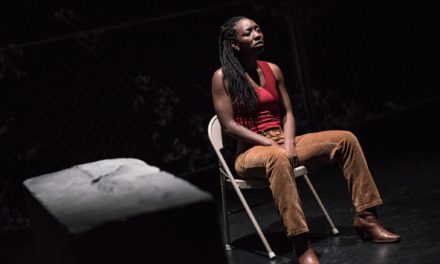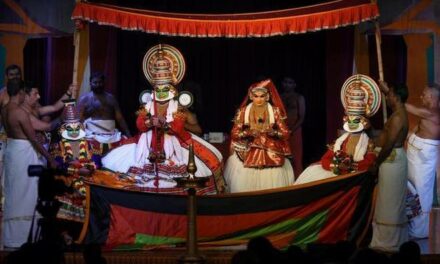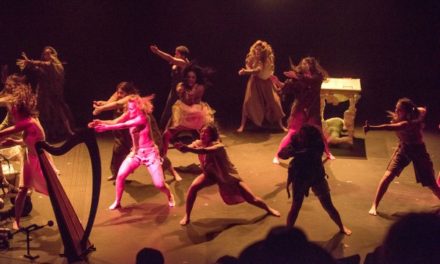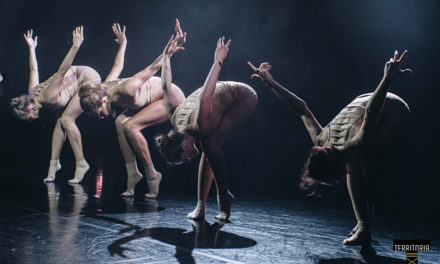Sansluxe, meaning “without luxury” in French, is a collaborative space that Montreal dancers in the city’s renowned gay village can use for the small fee of $40.00 per year. In February, dancers from the Sansluxe collective displayed their work with three nights of performances. This was an opportunity for the artists to express their unique styles, in their production “Les Soirées Sansluxe,” which translates to “The Sansluxe Evenings.”
On the second evening of performances, “Place-des-Arts,” in downtown Montreal, was honored to witness a spectacular crew of contemporary dancers. The members of the Sansluxe collective demonstrated a range of styles and finesse; from an eight-member locking crew to the solo brilliance of Lakesshia Pierre-Colon. The synthesis and momentum built throughout the night were balanced, completing the artistic experience.
The quaint theatre has a capacity of 200, typical of spaces in Montreal which exhibit contemporary dance performances. Although the dance scene does not attract overwhelming national attention, it is the locals who maintain and support the various events and for this reason, Sansluxe personifies Montreal dance culture. Sansluxe contracts performers and gives them a space in which to practice. The members of Sansluxe also represent the scene well by organizing intimate pieces to complement the development of dance in the city.
Et Si Ils Sifflaient (“And If They Hiss”) was the first piece of the evening, performed by Redmask. Responsible for establishing the initial atmosphere, Redmask is a three-member group influenced by Albert Camus’ “The Myth of Sisyphus.” Redmask borrows their technique from break-dance and contemporary philosophies. They began in a very lethargic fashion, but their movements quickened with the musical accompaniment’s crescendo. Although their performance built a tense atmosphere, it lacked closure as they exited the stage.

The performers. Photo by Alain Wong
Marc “Scramblelock” Sakalauskas and Lockunity picked up where Redmask left off with a piece titled Requiem. Locking tends to be an upbeat, funk-inspired dance style that involves locking one’s body in a position and then speeding up movement once again. However, this performance redefined locking by portraying emotions that are not generally associated with this artistic technique. The eight-person crew performed an emotional tribute to a lost friend, represented on stage by a coffin. Punching motions, particular to locking, were used to depict dancers’ angst and rage. Following the funeral piece, the crew re-emerged wearing bright costumes and various accessories. Upon their second entry, they danced with the joy that is generally affiliated with locking and spread this feeling among the crowd.
The innovative form that Requiem took could be a trend that locking artists begin to put into effect over the next few years, due to local dancers uncovering and being the catalysts for different trends within the dance community. For example, a new style of dance that has emerged from Montreal recently is Crumping, which involves the over-exaggeration of muscle contractions associated mostly with high-beat-per-minute electronic music such as dubstep. The anger portrayed by Lockunity and Marc Sakalauskas through locking was unconventional; however, this could prove to be a new style that emerges from the Montreal dance scene.
Namo Chanethomvong and Fanny Renier slowed the tempo once again with an untitled piece, in which their movements were coordinated so that their elegant bodies became nearly indistinguishable. Their performance told the story of two individuals intertwined due to their shared love for dance. The piece featured smooth bodily transitions while ensuring that the dancers maintained their individuality.
Following the Chanethomvong and Renier duo was Lust and Found, performed and choreographed by Lakesshia Pierre-Colon. She took stage in a dull, loose, grey costume with tears everywhere; this outfit amplified the sense of desperation she was attempting to portray. She exuded a personal struggle in which her only refuge was a stool brought with her on stage. This prop served as a safe space, although one that could only be taken advantage of momentarily. Pierre-Colon’s body manipulation and rhythmic movements provided the audience with a true spectacle that would leave a lasting impression on anyone.
The penultimate act was entitled Bardo, a word that describes the place between death and rebirth. Two dancers, Pax and Sangwn, entered the stage connected by a rope that was used to stop the other’s escape whenever they got within any meaningful distance of their desired goal. The audience experienced a feeling of despair as the performers battled each other to escape purgatory although bound perpetually. This emotional fight was intensified by their resistance to each other’s liberation.
To close the show, Crash and Create presented their piece Toyz, in which performers dressed as puppets and dolls lead the audience on a journey of discovery after having emerged from lifelong imprisonment. Once freed from the boxes that kept them for their whole lives, the dancers were able to move across their conceived reality without restraints. Exploring the world for the first time, each had individual fascinations while still being able to maintain a coordinated rhythm.
Although there was no overarching cohesion between the various groups of performers, the entire show was well choreographed. Individual pieces have a limited ability to tell a particular story and are never as complete as full performances based on one premise. However, this group of dancers created gripping stories that entertained the audience. The collective of performers is also typical of Montreal, as groups do well to perpetuate the idea of their small dance community.
The night of performances was a rollercoaster of emotions as Lust and Found instilled fear through an unseen force while the second half of the locking collective’s Requiem gave the audience a sense of joy. Another outstanding display was that of Pax and Sangwn, who communicated the duality of man through their escapist piece countered by their desire to remain in an eternal existence. Ultimately, the evening among members of the Montreal dance elite was emotional and thought-provoking.
This post was written by the author in their personal capacity.The opinions expressed in this article are the author’s own and do not reflect the view of The Theatre Times, their staff or collaborators.
This post was written by Brendan Irish.
The views expressed here belong to the author and do not necessarily reflect our views and opinions.



















